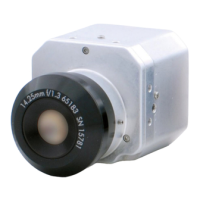17
Temperature Measurement
for Automated Processes
Temperature Measurement
for Automated Processes
Background
In Chapter the emphasis was on
specic applications where a single
temperature threshold is programmed
into an IR camera, and when the
threshold is reached an alarm is
triggered through a PLC. Multiple
cameras are often required, but viewing
an IR cameras’ thermographic image
is a secondary consideration – to
verify an alarm condition. Chapter 3
focuses on applications where multiple
temperatures within a single camera’s
FOV are important, and that information
is used for some sort of process control
function. In these applications, the
camera is typically integrated with other
process control elements, such as a PC or
PLC using third party software and more
sophisticated communication schemes.
Typical Camera Measurement
Functions
Many IR cameras provide the user with
dierent operating modes that support
correct temperature measurements
under various application conditions.
Typical measurement functions include:
Spotmeter•
Area•
Image mask•
Delta T•
Isotherm•
Temperature range•
Color or gray scale settings•
The last two are used with the others to
provide a visual indication of the range
of temperatures in the camera’s FOV.
Generally, spot and area temperatures
tend to be the most useful in monitoring
and control applications, and most
cameras allow multiple spots or areas to
be set within the thermographic image.
For example, the FLIR A320 camera
supports up to four spots and four areas.
Cursor functions allow easy selection of
an area of interest, such as the crosshairs
of the spot readings in Figure 1. In
addition, the cursor may be able to select
circlular, square, and irregularly shaped
polygon areas.
Figure 1. IR image of a printed circuit board
indicating three spot temperature readings.
Image colors correspond to the temperature
scale on the right.
The spotmeter nds the temperature
at a particular point. The area function
isolates a selected area of an object or
scene and may provide the maximum,
minimum, and average temperatures
inside that area. The temperature
measurement range typically is
selectable by the user. This is a valuable
feature when a scene has a temperature
range narrower than a camera’s full-
scale range. Setting a narrower range
allows better resolution of the images
and higher accuracy in the measured
Chapter 3

